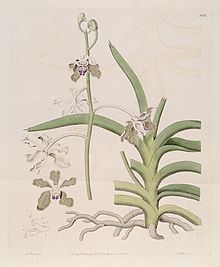- Vanda tessellata
-
Vanda tessellata 
Vanda tessellata illustration Scientific classification Kingdom: Plantae (unranked): Angiosperms (unranked): Monocots Order: Asparagales Family: Orchidaceae Subfamily: Epidendroideae Tribe: Vandeae Subtribe: Aeridinae Genus: Vanda Species: V. tessellata Binomial name Vanda tessellata
(Roxb.) Hook. ex G.DonSynonyms Contents
Description
Vanda tessellata is a species of orchid occurring from the Indian subcontinent to Indochina. It is a medicinal epiphytic perennial, stem 30-60 cm long, stout, scandent by the stout, simple or branching aerial roots. Leaves succulent, 15-20 cm, long, linear, recurved, complicate. Flowers in 6-10 flowered racemes, reaching with the peduncle 15-25 cm long. Sepals yellow, tessellated with brown lines and with white margins. Petals yellow with brown lines and white margins, shorter than the sepals. Lip 16 mm long, bluish, dotted with purple. Capsules 7.5-9 cm long, narrowly clavate-oblong with acute ribs.
Medicinal Uses
The roots are alexiteric and antipyretic; useful in dyspepsia, bronchitis, inflammations, piles and hiccup. Externally the root is used in rheumatism and allied disorders and diseases of the nervous system. It is also remedy for secondary syphilis and scorpion-sting. Juice of the leaves is given in otitis and the paste as febrifuge. The roots possess significant anti-inflammatory activity (Ghani, 2003).
Chemical composition
The plant has an alkaloid, a glucoside, tannins, β-sitosterol, γ-sitosterol and a long chain aliphatic compound, fatty oils, resins and colouring matters. Roots contain tetracosyl ferrulate and β-sitosterol-D-glucoside (Ghani, 2003; Rastogi & Mehrotra, 1990).
Traditional Practices
In Yunani system root is used as tonic to the liver and brain ; good for bronchitis, piles, lumbago toothache, boils of the scalp; lessens inflammation; heals fractures. The root is said to be fragrant, bitter and useful in rheumatism and allied disorder, in which it is prescribed in a variety of forms. It also enters the composition of several medicated oils for external application in rheumatism and diseases of the nervous system. In Chota Nagpur, the leaves pounded into a paste is applied to the body during fever. A compound decoction of this root is being administered in a case of Hemiplegia as the Indian physicians consider it useful in all nervous diseases and rheumatism. The leaves are pounded and the paste is applied to the body to bring down fever; their juice is dropped in the ear for the treatment of Otitis media and other inflammatory conditions. The roots are used in Dyspepsia, Bronchitis, Rheumatism, and also in fever; they are reported to possess antibacterial and antitubercular properties. The roots are used in the preparation of medicated oils, used externally in rheumatism and nervous troubles. The herb is also used for Sciatica. The leaves are used by the Santal girls for making anklets.
This Vandeae-related article is a stub. You can help Wikipedia by expanding it.
